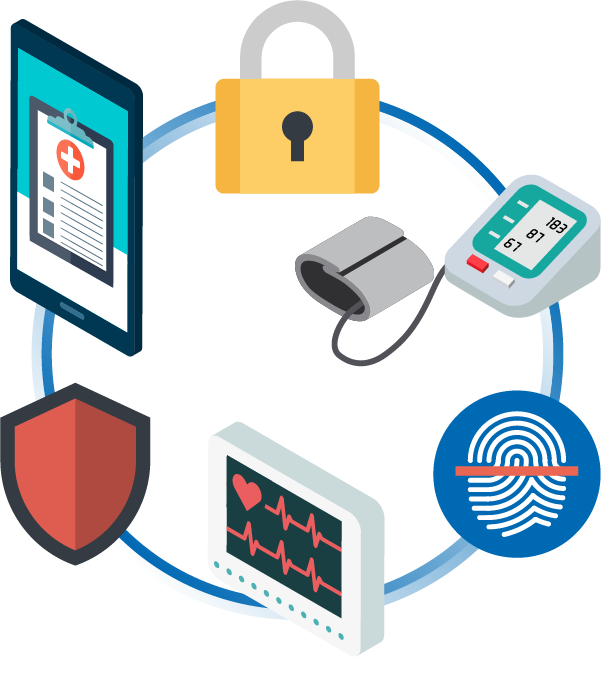Blog posts
Safeguarding eHealth: Cybersecurity in IoT
Published on 22 December 2023
In recent years, the integration of Internet of Things (IoT) devices in the eHealth sector has revolutionized
healthcare delivery. These interconnected devices, ranging from wearable fitness trackers to implantable medical
devices, have enhanced patient care, diagnosis, and treatment. However, with the benefits of IoT come significant
cybersecurity challenges that must be addressed to ensure the privacy and safety of patient data and the
reliability of healthcare services.
Besides, most IoT manufacturers don’t give enough importance to security aspects of their products. This
situation makes causes additional work and costs to developers and implementers who rely on these products [1] [2].

IoT devices in eHealth encompass a wide range of technologies, including remote patient monitoring systems,
smart medical devices, and telemedicine platforms. These devices collect, transmit, and analyse vast amounts
of sensitive patient data, such as personal health information (PHI), medical records, and vital signs.
While these advancements offer unprecedented opportunities for personalized healthcare and remote patient
management, they also create new avenues for cyber threats and attacks [3].
This is the exact scenario in which the CAREPATH platform operates, with its array of eHealth and wearable
devices and environmental sensors.
The following list shows the main threats that the IoT devices can encounter nowadays.
Data Privacy Concerns: The sheer volume of sensitive patient data stored and transmitted by IoT devices makes them lucrative targets for cybercriminals. Unauthorized access to this data can lead to identity theft, medical fraud, or even extortion.
Device Vulnerabilities: Many IoT devices lack robust security features due to cost constraints or design limitations. Vulnerabilities such as hardcoded passwords, outdated firmware, and insecure communication protocols make them susceptible to exploitation by hackers.
Network Security: The interconnected nature of IoT ecosystems introduces vulnerabilities at various points in the network infrastructure, including routers, gateways, and cloud servers. Compromising any of these components can disrupt healthcare operations or compromise patient data integrity.
Malware and Ransomware: IoT devices are vulnerable to malware and ransomware attacks, which can disrupt healthcare services, hijack devices for botnet activities, or encrypt critical patient data for ransom. [4]
Therefore, the mitigation of the cybersecurity threats has become an urgent task for all organizations
employing IoT infrastructures.
Below we list some possible countermeasures to deal with the cyberthreats that can occur in IoT.
Encryption and Authentication: Implementing strong encryption algorithms and multifactor authentication mechanisms can safeguard data in transit and prevent unauthorized access to IoT devices. In CAREPATH this is accomplished in all features exposed to the outside world by various techniques, for example with the use of OAuth 2.0 to authorize users to the Web platform and mobile application, or with a digitally signed token (JWT) in the encryption and exchange of securitized data from IoT devices and between the mobile device (tablet) and the central system.
Regular Software Updates: Manufacturers should provide timely security patches and firmware updates to address known vulnerabilities and improve the resilience of IoT devices against emerging threats. CAREPATH’s quality policy takes care to procure IoT equipments from manufacturers who guarantee regular updates and security patches of their firmware.
Network Segmentation: Segregating IoT devices into separate network segments limits the impact of security breaches and prevents lateral movement by attackers within the network.
Continuous Monitoring and Intrusion Detection: Deploying intrusion detection systems (IDS) and security information and event management (SIEM) solutions enables real-time monitoring of IoT network traffic and alerts administrators to potential security incidents. [5]
In conclusion, as the eHealth industry continues to embrace IoT technologies, ensuring the cybersecurity of interconnected medical devices is paramount to safeguarding patient privacy and maintaining the integrity of healthcare services. By adopting proactive security measures and staying abreast of evolving cyber threats, healthcare organizations can harness the full potential of IoT while minimizing the associated risks [6].
References
- Jansen, L.J.A. (2022), “Assessing smart home security : a Zigbee case study” , https://essay.utwente.nl/89274/
- Juliana Kenny, Steph Trejos, “Is Bluetooth Safe? How Bluetooth Hacking Happens and How to Prevent It”, in All About Cookies , https://allaboutcookies.org/can-bluetooth-be-hacked
- ScienceDirect, “Role of IOT in healthcare: Applications, security & privacy concerns” , https://www.sciencedirect.com/science/article/pii/S2949866X24000030
- Abdul Razaque; Fathi Amsaad; Meer Jaro Khan; Salim Hariri; Shujing Chen; Chen Siting; Xingchen Ji, “Survey: Cybersecurity Vulnerabilities, Attacks and Solutions in the Medical Domain”, IEEEXplore , https://ieeexplore.ieee.org/abstract/document/8888271
- Áine MacDermott; Phillip Kendrick; Ibrahim Idowu; Mal Ashall; Qi Shi, “Securing Things in the Healthcare Internet of Things”, IEEEXplore , https://ieeexplore.ieee.org/document/8766383
- Symantec, “Adopting the NIST Cybersecurity Framework in Healthcare” , https://docs.broadcom.com/doc/adoping-the-nist-cybersecurity-framework-in-healthcare-en
 This project has received funding from the European Union’s
Horizon 2020 research and innovation programme under grant
agreement No 945169
This project has received funding from the European Union’s
Horizon 2020 research and innovation programme under grant
agreement No 945169